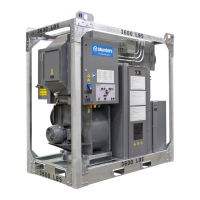Manual# I27028 3-7 Rev. 2 – 11/22/2017
3.3 CONTROL SYSTEM AND POWER DISTRIBUTION
The R-Series unit is controlled by a “programmable logic controller” or “PLC.” The PLC
is a small computer which executes a simple set of commands or “program.” The
program is organized as a loop which repeats continuously. LEDs on the front of the
PLC show the status of each of the inputs and outputs. For more information on these
LEDs, see the section on “Troubleshooting.”
Different variations of the unit operate on either 460V or 575V three-phase AC power.
The blowers use this voltage. Motor starters are provided for each of the blower motors.
The PLC changes or “modulates” the power going to the heating elements or gas
flowing to the burner, depending on the mode of operation. A transformer provides
115V AC, which is used by the controls and indicators in the unit.
If a blower motor is jammed, it will start to draw a large amount of electrical current. Each
of the motor starters can detect this condition, and shut down the faulty motor
automatically. This will also shut down the rest of the unit. Each motor starter can be
reset by pressing the “Reset” button on the starter.
3.4 ENERGY MODULATION
The reactivation heaters and burners are sized to provide enough heat to remove the
maximum amount of moisture the unit was designed to handle. The R-Series unit is
efficient because the heat input can be changed or “modulated.” The heaters will
always supply enough heat to keep the wheel in “equilibrium.” This means that the
wheel releases moisture at the same rate it is being absorbed. Because the heat input
can be modulated, less energy is used when the moisture load drops.
As the reactivation air passes through the wheel, the air temperature drops (the
moisture “cools off” the reactivation air as it evaporates off the wheel.) Tests have
shown that when the wheel is in equilibrium, the ideal temperature at the reactivation
outlet is 120°F.
There are four factors which affect the temperature at the reactivation outlet:
• Changes in temperature at the reactivation inlet
• Changes in the flow of reactivation air
• Changes in moisture loads in the process air stream
• Changes in the amount of heat provided by the heat source
If the temperature at the reactivation outlet is higher than 120°F, this does not
necessarily indicate a problem. A low outlet temperature indicates a potential problem.
There are four possible causes for a low outlet temperature:
• Large drop in temperature at the reactivation inlet
• Large drop in flow of reactivation air
• Large increase in moisture load in the process air stream
• Reduced output from the reactivation heaters
The controller will issue a warning if the machine operates for over 30 minutes with the
temperature below 110°F.
The reactivation heaters are designed to produce enough heat to handle the full design
moisture load. If the moisture load is less than maximum, the amount of energy input may
be reduced. The amount of energy used is controlled or “modulated” to maintain a

